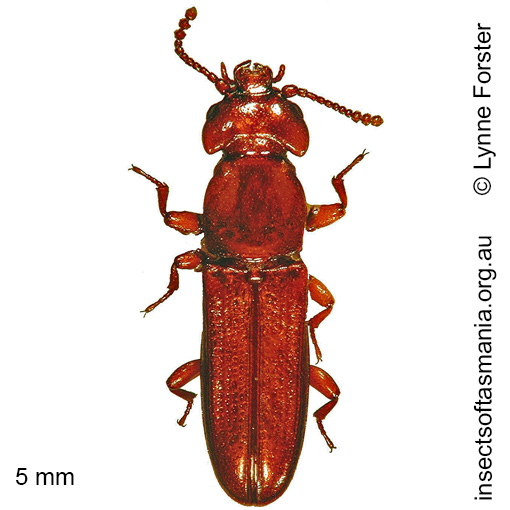
Dryocora cephalotes (a species of red log-beetle)
Basis for Tasmanian occurrence
Semmens, T.D., McQuillan, P.B. & Hayhurst, G. (1992). Catalogue of the Insects of Tasmania. Government of Tasmania: Department of Primary Industry, 104 pp. (as Dryocora cephalotes)
TMAG collections
Classification
Order: Coleoptera
Suborder: Polyphaga
Superfamily: Tenebrionoidea
Family: Prostomidae
Morphology
Typical length (mm): 5
Flightedness: winged and assumed capable of flight
Morphology (characterised by L. Forster): — Antennae with segments 2 to 6 not at all transverse; club with three segments — Body flat, polished, glabrous — Head strongly transverse, with large basal lobes — Pronotum longer than wide; narrower at apex — Wings present.
Source literature on morphology and taxonomy (*primary taxonomic source, where identified):
Lea, A.M. (1904b). Descriptions of new species of Australian Coleoptera, Part VII. Proc. Lin. Soc. NSW 29: 60-107. [Page 87].
Ecology
Assumed larval feeding: wood-feeder
Association with dead wood or old trees: obligately saproxylic
Ecological attributes: — Associated with cerambycid larval damage in wood (Harrison, 2007) — Associated with mudguts (Harrison, 2007) — Associated with wet brown cubic rot (Harrison, 2007) — May occupy logs or trunks of Eucalyptus obliqua, at least temporarily, since found having emerged within six years of felling (Grove et al., 2009).
Collection method(s) for TMAG material: — Baited trapping (funnel trap) — Emergence trapping from log of Eucalyptus obliqua — Hand collection (substrate not specified) — Knockdown fogging of canopy of Nothofagus cunninghamii — Sticky trapping on Eucalyptus obliqua — Trapping using a range of devices placed in crown of Eucalyptus obliqua (Bar-Ness, 2005) — Trunk window trapping (Harrison, 2007).
Source ecological literature:
Bar-Ness, Y. (2005). Crown structure and the canopy arthropod biodiversity of 100 year old and old-growth Tasmanian Eucalyptus obliqua. Msc thesis, Univ. of Tasmania, Hobart.
Grove, S. et al. (2009). A long-term experimental study of saproxylic beetle … succession in Tasmanian Eucalyptus … logs… In: Fattorini, S. (Ed.), Insect Ecology and Conservation. Research Signpost, pp. 71-114.
Harrison, K.S. (2007). Saproxylic beetles associated with habitat features in Eucalyptus obliqua trees in the southern forests of Tasmania. PhD thesis, Dept. of Zoology, Univ. of Tasmania, Hobart.
Yee, M. (2005). The ecology and habitat requirements of saproxylic beetles native to Tasmanian wet eucalypt forests: potential impacts of commercial forestry practices. PhD thesis, Univ. of Tasmania, Hobart.
Yee, M. et al. (2006). Brown rot in inner heartwood: why large logs support characteristic … beetle assemblages … In Grove, S.J. & Hanula, J.L. (eds.) Insect biodiv. and dead wood, pages 42-56. USDA For. Serv., SRS.

